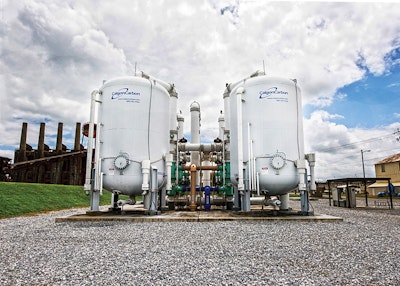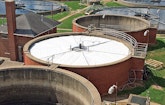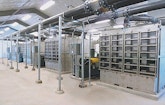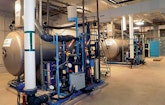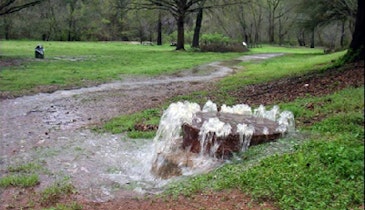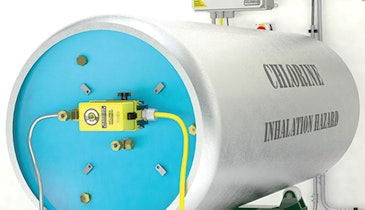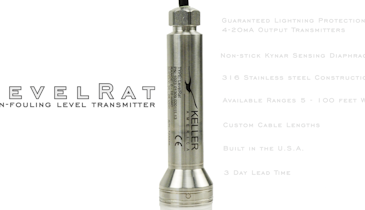Interested in Odor Control?
Get Odor Control articles, news and videos right in your inbox! Sign up now.
Odor Control + Get AlertsSoftware allows for prediction of odorous compound adsorption capacity in activated carbon
Problem: The Philips Research facility in Eindhoven, Netherlands, needed a system to estimate volatile organic compounds (VOC) on the activated carbon air filters it manufactures to remove taste and odor from drinking water. The facility wanted software to predict the capacity of activated carbon to adsorb odorous compounds.
Solution: VOC AC Adsorption with Relative Humidity Effects software from Activated Carbon Services – PACS gave plant management an easy way to predict VOC adsorption performance. The software has 888 VOCs in its database and is easy to use. The operator enters the adsorbate to get a two-page report with activated carbon influent concentration versus activated carbon capacity in grams per 100 grams of carbon. VOC concentrations from parts per trillion to parts per million are converted to activated carbon loading capacities.
Result: This software has consistently predicted VOC adsorption. 800/367-2587; www.pacslabs.com
Biotrickling system provides odor treatment for upscale neighborhood
Problem: Constant odor complaints led the town of Mooresville, North Carolina, to seek a solution. A 3 mgd pump station between an upscale housing community and the Mooresville Golf Club was causing issues for golfers and residents.
Solution: The town chose the Airashell Odor Treatment System from Anua for its effectiveness in treating high-strength odor, ease of operation and low life-cycle cost. The biotrickling system uses recycled seashells to break down odor compounds and buffer pH.
Result: The installation has ended odor complaints. “This system works well with very little maintenance,” says Doye Baker, field operator. “Our field operations team is very busy and this saves us a lot of time and energy.” 336/547-9338; www.anuainternational.com
Ozone treatment eliminates musty water taste
Problem: The Regional Municipality of Halton in Ontario supplies more than 1.3 mgd of drinking water sourced from Lake Ontario. Algal blooms on the surface of the lake between July and November transfer organic compounds like geosmin and 2-MIB into the water, creating a musty or earthy taste.
Solution: Metawater proposed a system incorporating high-efficiency ElectrOzone ozone generators from Aqua-Aerobic Systems into a multiplant approach, with recommendations for a 550 kg/day system at the Burlington plant, a 480 kg/day system at the Oakville plant, and a 180 kg/day system at the Burloak purification facility. After securing the contract, the construction process proceeded quickly, with the Burlington plant coming online in 2004, and the Oakville and Burloak systems started up in 2008.
Result: The ozone treatment system was able to eliminate foul tastes and odors, resulting in a 50 percent reduction in the number of complaints about the taste of the water. The flocculation and separation of particulate matter earlier in the treatment process reduced the load on the plant filtration systems, nearly doubling the runtimes of the filters between backwashing. Disinfection byproducts such as THMs and HAAs were reduced by 30 to 40 percent on average, due to precursor elimination by way of ozone oxidation. 815/654-2501; www.aqua-aerobic.com
Biofilter helps eliminate lift station odors
Problem: The city of Denver, Colorado, was concerned about a foul odor from a new wastewater lift station being built in a rapidly developing residential and commercial area. The city sought a reliable odor control system that would need minimal maintenance and could accommodate substantial future development.
Solution: The city chose a Bohn Biofilter to eliminate 1,700 cfm of foul air from the lift station’s wet well. The system biologically oxides the odor without regular nutrient addition.
Result: The city has a natural and effective odor-control solution that met its key objectives. 520/624-4644; www.bohnbiofilter.com
Carbon helps drinking water provider achieve compliance
Problem: Shelby County Water Services in Westover, Alabama, needed help complying with the U.S. EPA’s Stage 2 Disinfection Byproduct Rule.
Solution: The plant installed four of Calgon Carbon’s 14-foot-diameter Model-14 pressure vessels containing granular activated carbon, which adsorbs the naturally organic matter, measured as TOC, leaving less material in the water for reaction with the disinfectant chemical, reducing disinfection byproduct formation potential.
Result: Since the installation, disinfection byproduct levels throughout the distribution system remain in compliance. Installation of the system preempted the impact of the Stage 2 Rule, ensuring Shelby County’s water was in continuous compliance during the transition from Stage 1 to the more stringent Stage 2. 800/422-7266; www.calgoncarbon.com
Biofiltration unit helps eliminate hydrogen sulfide odors at lift station
Problem: The city of Hot Springs, Arkansas, had a long-standing problem with hydrogen sulfide and other odors at a lift station. The city asked odor-control consultant Webster Environmental Associates (WEA) to recommend a permanent solution.
Solution: WEA chose EcoVerde after a 90-day trial and monitoring to confirm successful H2S removal. The company installed its biofiltration unit in May 2016 and ran the 90-day trial. An EcoVerde technician and a WEA representative ran the performance test.
Result: The successful trial convinced the city to make the installation permanent. The results were so definitive that the city purchased two more units for lift stations that had similar odor issues. 888/330-0772; www.ecoverdetechnologies.com
Treatment plant controls odors with modular covers
Problem: The Town Branch Wastewater Treatment Plant in Lexington, Kentucky, serves a population of 130,000 and treats almost 11 billion gallons of wastewater annually. The plant needed to replace failing steel-dome gas-collecting tank covers with odor control to help maintain a more consistent temperature in the tanks throughout the year.
Solution: The plant team chose insulated modular covers from Geomembrane Technologies to cover a blending tank, two secondary digesters and a sidestream holding tank. The covers were tailored to fit around central floating mixers in each tank, so there is no upwelling.
Result: The customized covers effectively control odors and so maintain community relations and worker satisfaction. The durable covers can be walked on, and allow individual panels to be removed and replaced to accommodate routine maintenance. The covers were installed without interfering with plant operation. 855/484-4630; www.gticovers.com
Biological control system eliminates severe odors
Problem: The Palomar Commons Shopping Center in Carlsbad, California, stands next to a sewer main along the Buena Outfall Interceptor, which routes sewage to the Encina Wastewater Authority Water Pollution Control Facility. The city needed a sustainable, environmentally friendly odor control solution.
Solution: The city chose a hybrid biological odor control system from Integrity Municipal Systems. The packaged I-BOx 6000 biological system consists of a fiberglass-reinforced plastic (FRP) air exhaust fan, an FRP dual-stage odor-control vessel, water and nutrient feed panel, nutrient tank and electrical control panel. The system was installed and started up in a few hours.
Result: With inlet H2S concentrations from 150 to 250 ppm, the system has maintained more than 99 percent removal efficiency. Community odor complaints have been eliminated. Minimal maintenance keeps operating cost low. 858/486-1620; www.integrityms.net
Air strippers remove volatile compounds in city’s drinking water
Problem: The U.S. Army Corps of Engineers funded the design and construction of a new plant in Cheyenne, Wyoming, to treat groundwater from the city’s Borie wellfield. The water was apparently contaminated with tricholorethene (TCE) in the late 1960s.
Solution: “For the given application, the most logical and cost-effective groundwater treatment choice was low-profile air strippers,” says Matt Moughamian, project manager with McMillen LLC. He chose the E-Z Tray from QED Environmental Systems. Four six-level, 1,000 gpm E-Z Tray Air Strippers meet the TCE treatment goal of less than 2 ppb without pretreatment. The units do not require off-gas treatment or sequestering agents. Turbulent mixing in the units creates a high air-to-water ratio and large mass transfer surface area, enabling efficient contaminant removal.
Result: “The water goes straight from the Cheyenne wells into the E-Z Trays, and the air strippers have been in constant operation since July 2011 with no need to clean the trays because of buildup or fouling,” says Moughamian. The units handle the contamination load, “and there have been no issues so far.” 800/624-2026; www.qedenv.com
Hose pumps a fit for extreme-duty carbon slurry application
Problem: The Coddle Creek Wastewater Treatment Plant near Charlotte, North Carolina, had been dosing polyaluminum chloride from a wet well with mixed results for several years. When a submersible pump failed three times in a year, maintenance and operations management sought an alternate solution.
Solution: Plant management installed Verderflex Dura-series hose pumps from Verder. The pumps deliver a 31-foot dry suction lift, and the bottom of the wet well is 27 feet from the floor of the pump room. Using a flow-paced controller, the pump transfers from the wet well and doses according to plant demand. Peristaltic pumps are abrasion resistant, allowing slurry to gently pass through the hose without using check valves. The pumps include a vertical motor, one-piece flange assembly and extended hose life.
Result: The pumps help the plant save money and energy by reducing downtime. 877/783-7337; www.verder-us.com
